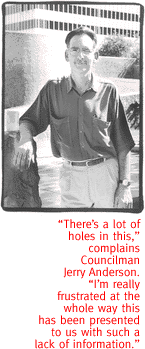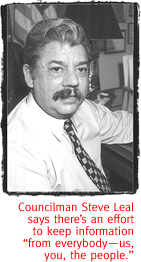

|

The City Manager Wants To Build A Monument-But Why?
By Jim Nintzel
FOR SEVERAL MONTHS, Tucson City Manager Luis Gutierrez
has been working on a hush-hush development project with some
top city staffers. Last week, in a slide show that emphasized
many problems with the existing City Hall, he finally unveiled
his vision of a towering new municipal headquarters.
While some elements of the pitch had leaked to The Weekly
in the days leading up to the meeting, Gutierrez had kept the
details tightly under wraps.
"It's been so secret I thought they might be planning to
build it underground--kind of an X-Files thing," says
Ward 1 Councilman José Ibarra.
 But the Plaza de Luis, as Ibarra calls to the new City Hall project,
would actually rise 12 stories into the downtown skyline, a "state-of-the-art"
public facility which would open for business in April 2001.
But the Plaza de Luis, as Ibarra calls to the new City Hall project,
would actually rise 12 stories into the downtown skyline, a "state-of-the-art"
public facility which would open for business in April 2001.
The $57-million skyscraper is part of a $75-million development
package which also includes a new midtown police station and Council
office (Price tag: $9 million). The existing City Hall would be
rehabilitated for additional office space, possibly for the Transportation
and Parks & Rec departments, for an additional $7.5 million;
and Parks & Rec's current headquarters in Reid Park would
be demolished to make room for zoo expansion, more playing fields
or additional parking space--at $1.5 million--for Hi Corbett Field.
Following the presentation, Ward 6 Councilman Fred Ronstadt made
a motion to proceed with Gutierrez's recommendation to begin the
planning process for the development. Although Mayor George Miller
and Council members Shirley Scott and Janet Marcus appeared to
be leaning toward supporting the project, the Council instead
voted to hold a public meeting on Monday, August 17, before moving
forward.
This week, Ronstadt's support for the project began to wither.
"I've sort of soured on it," he says.
Like some of his colleagues on the Council, Ronstadt now says
he has some questions about the project that weren't answered
by the glossy, 100-page notebook on the project, which, while
describing the deal as a "win-win-win" for bureaucrats
and taxpayers, neglects to explain how the deal is actually going
to work. Instead, it's filled with statistics, photos and captions--what
one high-level staffer in the City Manager's Office describes
as "soft stuff. The Council likes soft stuff."
Councilman Steve Leal says he prefers hard data. Although he
tentatively supports the midtown development, Leal is skeptical
of the new City Hall and says he needs to see "real analysis.
Show us the numbers."
A week after the plan's debut, however, details remain sketchy.
Staffers in the City Manager's Office say the comic book they
gave Council members is the closest they've gotten to a summary
of the plan, although they hope to send a more in-depth review
of the project to Gutierrez this week, which he'll forward to
the Council members early next week--which means the Council gets
about a week to review the project before they vote on it following
a one-hour public meeting on August 17.
"There's a lot of holes in this," complains Councilman
Jerry Anderson. "I'm really frustrated at the whole way this
has been presented to us with such a lack of information."
Leal is more blunt, griping there's been an effort to keep information
"from everybody--us, you, the people."
 CITY FINANCE DIRECTOR Kay Gray has the real numbers--but,
like the City Manager's Office, she has no reports, no memos and
no public records she's willing to share with the press. She's
happy to discuss the broad elements of the plan, however.
CITY FINANCE DIRECTOR Kay Gray has the real numbers--but,
like the City Manager's Office, she has no reports, no memos and
no public records she's willing to share with the press. She's
happy to discuss the broad elements of the plan, however.
For starters, the real cost is still unknown. The city will spend
$75 million on the various developments, but it only has $6 million
available as a down-payment, so to speak. That $6 million, previously
kept as debt reserve on the city's bonds, is available because
the city refinanced the bond debt. Gray says these dollars can
only be used for capital projects.
The city will need to borrow the remaining $69 million for the
project, so interest payments on the so-called "certificates
of participation" will drive up the real cost. Gray estimates
the project will be paid off over 20 years, and a "rough
rule of thumb" to estimate the cost is to double the amount
you plan to borrow. So the eventual cost of the project could
run as high as $144 million.
These repayment details are glossed over in the briefing book
given to Council members and the press, which lists five revenue
sources without identifying how much will come from each one.
Gray was more forthcoming about details in an interview earlier
this week, although she declined to release some of her figures.
According to Gray:
- The city can get $1.8 million by selling general obligation
bonds approved by voters in 1965, which have never been issued.
The bonds must be used for law-enforcement needs.
- The city can save $115,500 annually it pays in rent for
the offices for the Office of Economic Development and Parks &
Rec's Kidco program. The staff also hopes to bring in $750,000
with the sale of the old Ward 6 Council Office and the midtown
police station.
- The city can divert $1.5 million from the general fund
which has been paid to Hughes Missile Systems for the last five
years. The money, tagged as "economic development" dollars,
would total $33 million over 22 years. Kay admits this money,
which comes from the general fund, could be used for nearly any
area of the budget.
- More general fund dollars will become available as the
city pays off debt it acquired to renovate the Tucson Convention
Center and the Temple of Music and Art.
"It would be like you having a car loan, and when you paid
your car-loan off, now your wife needs a car," says Gray.
"You can replace the payment, but it's been earmarked for
debt service all along. I put that in because every mayor and
council that I'm aware of have used debt-service proceeds in that
fashion, so you don't have a lot of spikes in the debt service,
and as you pay something off, you replace it for similar types
of function."
Over the next 20 years, the annual figures range anywhere from
$8,000 to $3.7 million, but grow to total about $55.5 million.
Although the money has traditionally been used for capital projects,
Gray says the dollars, like the economic development funding,
could be available to the general fund for any use.
- The remainder of the debt would be paid off through a
complex financing arrangement which involves dollars currently
used to service debt for other non-voter-approved bond debts.
As that debt is repaid or restructured, more dollars are available
for new debt.
Gray says this final item is flexible. "I have not done
a totaling of any of these, primarily because this was a conceptual
model for Mayor and Council and there's more resources here than
is needed for repayment of debt, but it was to give an idea that
it's not all coming from one place. I have ballpark figures, but
I'd really be uncomfortable giving that, because it gives people
the idea that it's a cast-in-stone number, and it's not. In both
these cases, it's dependent on how long in the future you would
go."
Asked if she's preparing a more in-depth report for Council review,
Gray says; "I haven't talked to the City Manager, except
briefly. We were asked questions at the presentation and we're
going back on August 17 with answers to those questions, but I
have not talked to the Manager about how he wants to approach
this piece of that. We've been kind of busy doing some other things."
 AT LEAST THREE Council members would feel a little better
about the proposal if some of these details could be spelled out
to them. Anderson had scheduled a meeting with Gray this week
to learn more about the financial plan.
AT LEAST THREE Council members would feel a little better
about the proposal if some of these details could be spelled out
to them. Anderson had scheduled a meeting with Gray this week
to learn more about the financial plan.
Leal complains, "When we met to talk about it the other
day, I thought it was just the beginning--not that there was a
bow wrapped around it and here it is."
Ibarra has similar concerns. "I didn't appreciate the fast-track,"
he says, arguing that the project "is not the highest priority
we need to be addressing."
Anderson, who had an office in the City Hall Annex when he worked
in the city's annexation division, is more sympathetic to the
needs of downtown city workers, but he's still leery about building
a new City Hall.
"I realize there's a need to improve City Hall, and certainly
the Annex is not only an unhealthy building to work in, but it's
woefully inadequate," Anderson says. "Something needs
to be done to both facilities. But my concern is that the Manager
has put together a $75 million package and doesn't want to go
to the voters for their approval."
Ibarra thinks the need for a new City Hall is a matter of perspective.
"It depends on whether you work there," Ibarra says.
"If you're George Miller, then you really need to replace
it. If you're José Ibarra and you're at the westside Council
office, it's not too bad."
Ibarra supports using capital construction funds to build recreational
centers on the city's northwest and east sides to help curb juvenile
crime. He thinks the City Hall proposal should go to the ballot.
"I would feel more comfortable if we did it through a bond
package," says Ibarra. "That way, the voters would have
a chance to vote for it."
With voter approval, Anderson says, "We can go together
knowing that we're being supported by our community--that despite
all the other needs we have throughout Tucson, whether it be parks
or service centers or safe neighborhoods or youth programs or
money for the cops, this is the priority the voters will support."
Leal thinks city staff needs to analyze the cost of operations
and maintenance for the new City Hall. He thinks the city might
be better off leasing additional office space and examining the
possibility of acquiring the federal court facilities at Broadway
and Scott Avenue.
Leal says city-county consolidation could also reduce the need
for additional office space, as could telecommuting. "How
many city employees could we keep at home--get 'em off the roads
and reduce air pollution?" Leal asks.
Ronstadt says he'll have a lot of questions at the August 17
meeting. He believes the new City Hall would help downtown revitilization,
but, "On the other hand, there are a lot of significant unmet
needs in the community," Ronstadt says. "To a degree,
I got caught up in the whole thing. I think it's a nice vision
for the future of the community and it's going to enhance the
ability to provide services for people who access city government
directly. But the more the details are being fleshed out, it's
not turning out to be so grand."

|
 |





